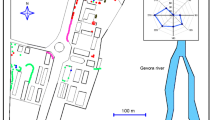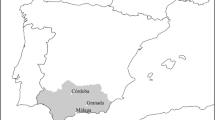Abstract
Airborne pollen emission model was used to determine pollen metrics and to examine their relationship with vineyard phenology in two wine regions of Northern Portugal: Vinhos Verdes (1993–2007) and Douro (1992–2011). A number of airborne pollen metrics were obtained through the rate of changes of logistic model adjusted to the time series of airborne pollen. In both regions, the mean absolute differences between observed phenology and model-predicted values for start, peak and final of flowering phenophases were always lower than 5 days and the slope of the regression through the origin is close to one. These metrics can be used to accurately and precisely predict the dynamic of Vitis flowering observed at field level. The model’s simplicity and flexibility are of great advantage for its practical use in aerobiology.




Similar content being viewed by others
References
Altman, D. G., & Bland, J. M. (1971). Measurement in medicine: The analysis of method comparison studies. Statistician, 221, 850–892.
Andersen, T. B. (1991). A model to predict the beginning of the pollen season. Grana, 30(1), 269–275.
Baggiolini, M. (1952). Les stades reperes dans le developpment annuel de la vigne et leur utilization pratique. Revue romande d’Agriculture et d’Arboriculture, 8, 4–6.
Brighetti, M. A., Costa, C., Menesatti, P., Antonucci, F., Tripodi, S., & Travaglini, A. (2014). Multivariate statistical forecasting modeling to predict Poaceae pollen critical concentrations by meteoclimatic data. Aerobiologia, 30(1), 25–33.
Cambon, G., Ritchie, J. C., & Guinet, P. (1992). Long-distance transport of airborne pollen in southern Ontario (Canada). Canadian Journal of Botany-Revue Canadienne De Botanique, 70(11), 2284–2293.
Charalampopoulos, A., Damialis, A., Tsiripidis, I., Mavrommatis, T., Halley, J., & Vokou, D. (2013). Pollen production and circulation patterns along an elevation gradient in Mt Olympos (Greece) National Park. Aerobiologia, 29(4), 455–472.
Cour, P. (1974). Nouvelles technique de détection des flux et des retombées polliniques: étude de la sedimentation des pollens et des spores à la surface du sol. Pollen et Spores XVI, 1, 103–141.
Cristofori, A., Cristofolini, F., & Gottardini, E. (2010). Twenty years of aerobiological monitoring in Trentino (Italy): Assessment and evaluation of airborne pollen variability. Aerobiologia, 26(3), 253–261.
Cunha, M., Abreu, I., Pinto, P., & Castro, R. (2003). Airborne pollen samples for early-season estimates of wine production in a Mediterranean climate of Northern Portugal. American Journal of Enology and Viticulture, 54(3), 189–194.
Cunha, M., Marcal, A. R. S., & Silva, L. (2010). Very early prediction of wine yield based on satellite data from VEGETATION. International Journal of Remote Sensing, 31(12), 3125–3142.
Davies, R. R., & Smith, L. P. (1973). Forecasting the start and severity of the hayfever season. Clinical Allergy, 4, 95–108.
Driessen, M. N. B. M., van Herpen, R. M. A., Moelands, R. P. M., & Spieksma, F. T. M. (1989). Prediction of the start of the grass pollen season for the western part of the Netherlands. Grana, 28(1), 37–44.
Duhl, T. R., Zhang, R., Guenther, A., Chung, S. H., Salam, M. T., House, J. M., et al. (2013). The simulator of the timing and magnitude of pollen season (STaMPS) model: A pollen production model for regional emission and transport modeling. Geoscientific Model Development Discussions, 6(2), 2325–2368.
Emberlin, J., Jaeger, S., Dominguez-Vilches, E., Soldevilla, C., Hodal, L., Mandrioli, P., et al. (2000). Temporal and geographical variations in grass pollen seasons in areas of Western Europe: An analysis of season dates at sites of the European pollen information system. Aerobiologia, 16(3–4), 373–379.
Estrella, N., Menzel, A., Krämer, U., & Behrendt, H. (2006). Integration of flowering dates in phenology and pollen counts in aerobiology: Analysis of their spatial and temporal coherence in Germany (1992–1999). International Journal of Biometeorology, 51, 49–59.
Feher, Z., & JaraiKomlodi, M. (1997). An examination of the main characteristics of the pollen seasons in Budapest, Hungary (1991–1996). Grana, 36(3), 169–174.
Fernández-Llamazares, Á., Belmonte, J., Boada, M., &, Fraixedas, S. (2013a). Airborne pollen records and their potential applications to the conservation of biodiversity. Aerobiologia, 30(2), 111–122.
Fernández-Llamazares Á., Belmonte J., Delgado R., Linares C. (2013b) A statistical approach to bioclimatic trend detection in the airborne pollen records of Catalonia (NE Spain). International Journal of Biometeorology, 58(3), 371–382.
Galán, C., Emberlin, J., Domínguez, E., Bryant, R. H., & Villamandos, F. (1995). A comparative analysis of daily variations in the Gramineae pollen counts at Córdoba, Spain and London, UK. Grana, 34, 189–198.
Giorato, M., Lorenzoni, F., Bordin, A., De Biasi, G., Gemignani, C., Schiappoli, M., et al. (2000). Airborne allergenic pollens in Padua: 1991–1996. Aerobiologia, 16, 453–454.
Helbig, N., Vogel, B., Vogel, H., & Fiedler, F. (2004). Numerical modelling of pollen dispersion on the regional scale. Aerobiologia, 3, 3–19.
Jarosz, N., Loubet, B., & Huber, L. (2004). Modelling airborne concentration and deposition rate of maize pollen. Atmospheric Environment, 38(33), 5555–5566.
Jato, V., Rodríguez-Rajo, F. J., & Aira, M. J. (2007). Use of phenological and pollen-production data for interpreting atmospheric birch pollen curves. Annals of Agricultural and Environmental Medicine, 14(2), 271–280.
Kasprzyk, I. (2003). Flowering phenology and airborne pollen grains of chosen tree taxa in Rzeszów (SE Poland). Aerobiologia, 19, 113–120.
Kasprzyk, I., & Walanus, A. (2010). Description of the main Poaceae pollen season using bi-Gaussian curves, and forecasting methods for the start and peak dates for this type of season in Rzeszow and Ostrowiec Sw. (SE Poland). Journal of environmental monitoring: JEM, 12(4), 906–916.
Kuparinen, A., Schurr, F., Tackenberg, O., & O’Hara, R. B. (2007). Air-mediated pollen flow from genetically modified to conventional crops. Ecological Applications, 17(2), 431–440.
Landis, J. R., & Koch, G. G. (1977). Measurement of observer agreement for categorical data. Biometrics, 33(1), 159–174.
Lejoly-Gabriel, M., & Leuschner, M. R. (1983). Comparison of airborne pollen at Louvain-La-Neuve Belgium and Basel Switzerland during 1979 and 1980. Grana, 1, 59–64.
Lin, L., & Torbeck, L. D. (1998). Coefficient of accuracy and concordance correlation coefficient: New statistics for methods comparison. PDA Journal of Pharmaceutical Science and Technology, 52(2), 55–59.
Martin, M. D., Chamecki, M., Brush, G. S., Meneveau, C., & Parlange, M. B. (2009). Pollen clumping and wind dispersal in an invasive angiosperm. American Journal of Botany, 96(9), 1703–1711.
Mullenders, W., Dirichx, M., & Haegen, D. V. (1972). La pluie pollinique à Louvain. Louvain Medical, 91, 159–176.
Nilsson, S., & Persson, S. (1981). Tree pollen spectra in the stockholm region (sweden), 1973–1980. Grana, 20(3), 179–182.
OIV, (2009). Code des caractères descriptifs des variétés et espèces de Vitis (2nd ed.). Organisation Internationale de la Vigne et du Vin (OIV).
Orlandi, F., Romano, B., & Fornaciari, M. (2005). Effective pollination period estimation in olive (Olea europaea L.): A pollen monitoring application. Scientia Horticulturae, 105, 313–318.
Osborne, C. P., Chuine, I., Viner, D., & Woodward, F. I. (2000). Olive phenology as a sensitive indicator of future climatic warming in the Mediterranean. Plant, Cell and Environment, 23, 701–710.
Pathirane, L. (1975). Graphical determination of the main pollen season. Pollen et Spores, 17, 609–610.
Ribeiro, H., Cunha, M., & Abreu, I. (2007). Definition of the main pollen season using a logistic model. Annals of Agricultural and Environmental Medicine, 14(2), 259–264.
Ribeiro, H., Cunha, M., & Abreu, I. (2009). A bioclimatic model for forecasting olive yield. Journal of Agricultural Science, 147, 647–656.
Rousseau D. D., Duzer D., Cambon G. V., Jolly D., Poulsen U., Ferrier J., et al. (2003) Long distance transport of pollen to Greenland. Geophysical Research Letters, 30(14), 1765.
Ruffaldi, P., & Greffier, F. (1991). Birch (Betula) pollen incidence in France (1987–1990). Grana, 30, 248–254.
Sánchez Mesa, J., Smith, M., Emberlin, J., Allitt, U., Caulton, E., & Galan, C. (2003). Characteristics of grass pollen seasons in areas of southern Spain and the United Kingdom. Aerobiologia, 19(3–4), 243–250.
Scheifinger, H., Belmonte, J., Buters, J., Celenk, S., Damialis, A., Dechamp, C., et al. (2013). Monitoring, Modelling and Forecasting of the Pollen Season. In M. Sofiev & K.-C. Bergmann (Eds.), Allergenic pollen (pp. 71–126). The Netherlands: Springer.
Siljamo, P., Sofiev, M., Ranta, H., Linkosalo, T., Kubin, E., Ahas, R., et al. (2008a). Representativeness of point-wise phenological betula data collected in different parts of Europe. Global Ecology and Biogeography, 17(4), 489–502.
Siljamo, P., Sofiev, M., Severova, E., Ranta, H., Kukkonen, J., Polevova, S., et al. (2008b). Sources, impact and exchange of early-spring birch pollen in the Moscow region and Finland. Aerobiologia, 24(4), 211–230.
Spieksma, F. T. M., Emberlin, J. C., Hjelmroos, M., Jäger, S., & Leuschner, R. M. (1995). Atmospheric birch (Betula) pollen in Europe: Trends and fluctuations in annual quantities and the starting dates of the seasons. Grana, 34(1), 51–57.
Torben, B. A. (1991). A model to predict the beginning of the pollen season. Grana, 30, 269–275.
Veriankaite, L., Siljamo, P., Sofiev, M., Sauliene, I., & Kukkonen, J. (2010). Modelling analysis of source regions of long-range transported birch pollen that influences allergenic seasons in Lithuania. Aerobiologia, 26(1), 47–62.
Weger, L., Bergmann, K., Rantio-Lehtimäki, A., Dahl, Å., Buters, J., Déchamp, C., et al. (2013). Impact of Pollen. In M. Sofiev & K.-C. Bergmann (Eds.), Allergenic pollen (pp. 161–215). The Netherlands: Springer.
Zhang, R., Duhl, T., Salam, M. T., House, J. M., Flagan, R. C., Avol, E. L., et al. (2013). Development of a regional-scale pollen emission and transport modeling framework for investigating the impact of climate change on allergic airway disease. Biogeosciences Discussions, 10(3), 3977–4023.
Acknowledgments
The authors would like to thank Carlos Coutinho (Estação de Avisos da Direcção de Agricultura e Pescas do Norte) and J.Pedro Pereira (Subvidouro) for providing the vineyard phenological data used for model validation. We also thank António Teixeira for assisting in the pollen collection.
Author information
Authors and Affiliations
Corresponding author
Rights and permissions
About this article
Cite this article
Cunha, M., Ribeiro, H., Costa, P. et al. A comparative study of vineyard phenology and pollen metrics extracted from airborne pollen time series. Aerobiologia 31, 45–56 (2015). https://doi.org/10.1007/s10453-014-9345-3
Received:
Accepted:
Published:
Issue Date:
DOI: https://doi.org/10.1007/s10453-014-9345-3




